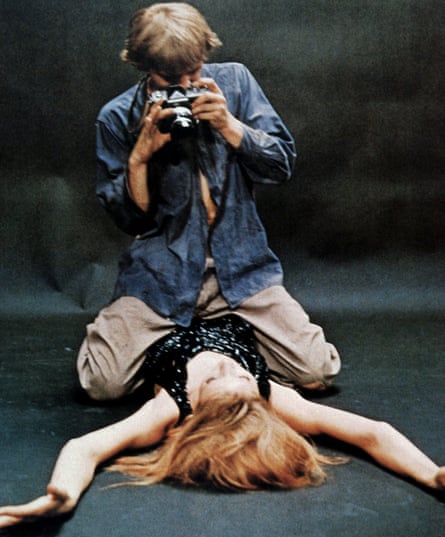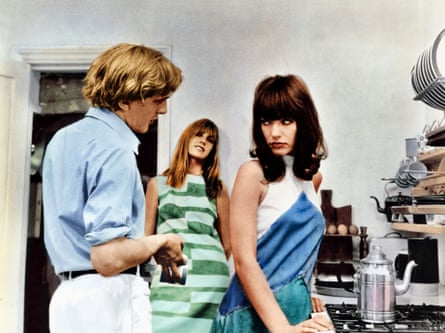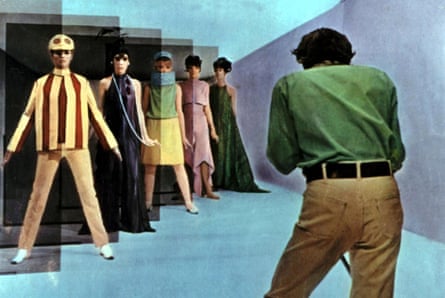You could say Blow-Up was my gateway drug into art cinema. For me, it was the perfect bridge between the British pop culture I knew and the European cinema I had yet to discover. And when I think of Cannes, despite so many great American winners, I immediately think of European film-makers – especially Italians. That’s just me.
I wasn’t alive when Blow-Up won the Palme d’Or in 1967 (not a vintage year but Robert Bresson’s Mouchette and Joseph Losey’s Accident were among its rivals), but its cultural impact was still reverberating 20 years later. I came to it third-hand, via the James Taylor Quartet’s version of the theme tune – an infectious slice of retro Hammond grooviness I first heard John Peel play in 1987. These were the pre-internet dark ages, don’t forget, so it took some detective work to deduce that it was a cover version, mashing up two songs from an album by Herbie Hancock (Deee-Lite’s Groove Is in the Heart would sample Hancock’s bassline a few years later), which was the soundtrack to a movie older cinephiles knew very well – which, back in the dark ages, I had little hope of seeing.

When I finally did see it, I wasn’t prepared for what a strange, beguiling movie it was. I’d expected a time-capsule of swinging London, and it’s one of the best. It’s all here: priapic photographers, louche models in pop couture, the Yardbirds, Vanessa Redgrave, Sarah Miles, Jane Birkin, that jazzy soundtrack, an open-top Rolls driving through the new 1960s city, David Hemmings’ white jeans and blue gingham shirt get-up (I went through my own white jeans phase as a result). But it was clear this is not a straightforward youth movie. Not a straightforward movie at all, in fact.
Blow-Up’s pivotal scene is one of those great sequences in which we’re simply watching someone completely absorbed in their work. We become just as absorbed, as Hemmings’ character (his name is Thomas, apparently) develops a roll of film, becomes convinced he’s spotted something, then runs back and forth from the darkroom, pinning up prints and piecing together what could be a murder conspiracy. No dialogue, no other characters, barely even any moving images, just a sequence of still photos from which a story could be inferred. Oh I get it – like cinema!
But this is not a detective story either. Rather than fitting together, the pieces of the puzzle gradually disappear. All the way to that mimed tennis match in the park. My teenage brain, groomed on 1980s Hollywood, wasn’t prepared for it. What was it all about then? It would take many more viewings, not just of this film, to understand.

Audiences at Cannes that year were probably better prepared. It was only seven years earlier that Antonioni first set the cat among the pigeons with L’Avventura, one of the turning points of modern cinema and a great Cannes moment by all accounts. Decadence, boredom, shallowness, narrative frustration, long takes in which nothing appeared to be happening – L’Avventura suddenly made narrative cinema look square. The film elicited boos from the Cannes audience, which is often a good sign, it turns out. It also won the Grand Jury prize, of course, and sealed Antonioni’s reputation.
So by the time Blow-Up came around, the critics had learned their lesson. The success of L’Avventura and its successors had made Antonioni a major force. He’d just signed a lucrative deal to make three English-language pictures for Italian producer Carlo Ponti, of which Blow-Up was the first (the other two were Zabriskie Point and The Passenger – both flops later acknowledged as masterpieces). Given the subject matter, expectations – and the booing threshold – must have been high, even if the premiere left some critics nodding in incomprehension.

The temptation to “decipher” Blow-Up has occupied a great many minds. The picture is scattered with what could be taken as clues: the deliberate use of colour, the use of black-and-white, the precise framing. Does the headless statue in the antique shop mean something? Is the propeller Thomas buys a symbol, or just a propeller? What is Vanessa Redgrave really doing in the park? How much should we read into the colour of the tights of the two groupies who interrupt his investigation? Is that point-of-view shot of the trees in the park, near the end, significant? Knowing Antonioni, it’s all there for a reason, but he once said of the film: “The moment you explain it, you betray it.” A film you could explain in words was “not a real film”.
The temptation to ascribe an autobiographical aspect to Blow-Up is also difficult to resist. Hemmings’ character is an image-maker, after all, a prince of pop culture but a slave to it, too. He only comes to life when he shakes off his commercial shackles and immerses himself in the purity of his craft (was Antonioni coming to regret that three-picture deal already?). Momentarily, Hemmings finds “meaning” in his images, but comes to realise it’s entirely subjective, just like his artist neighbour who works out what his paintings are about retrospectively, or the value of the smashed guitar neck from the Yardbirds gig which Hemmings fights so hard for, then chucks on the street when he gets outside, instantly rendering it junk.
Art only has the power we ascribe to it, Antonioni seems to be saying, cinema especially. And that power doesn’t last. By extension, Blow-Up seems to suggest swinging London itself was some agreed collective hallucination. No one looks as if they’re having a particularly good time, after all – not so much swinging as going through the motions (except for the mime troupe, perhaps, who are having a good time literally going through the motions).
Certainly Blow-Up’s power has faded over time. The movie was hailed as the best of the year, not just by Cannes but also by institutions such as the New Yorker and Time. Its cultural shadow loomed over subsequent decades (we’d never have had another Cannes classic, The Conversation, without it), but Hemmings’ hero now seems more of an arsehole, especially in his treatment of women. Subsequent parodies, such as Austin Powers, have also diminished it somewhat. Perhaps Blow-Up is approaching its own Blow-Up-like ending. Its intricate web of references and meanings held together, then melting away again, leaving audiences to wonder what anyone ever saw in it. But not yet I hope. It still means something to me.

